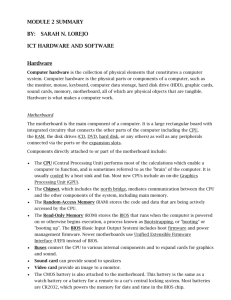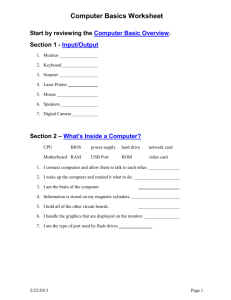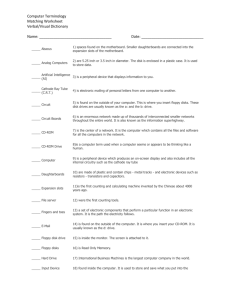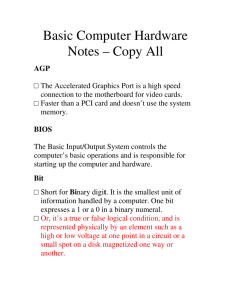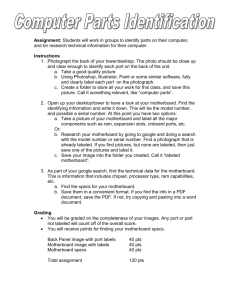Chapter 1 What's in a Computer, Anyway?
advertisement
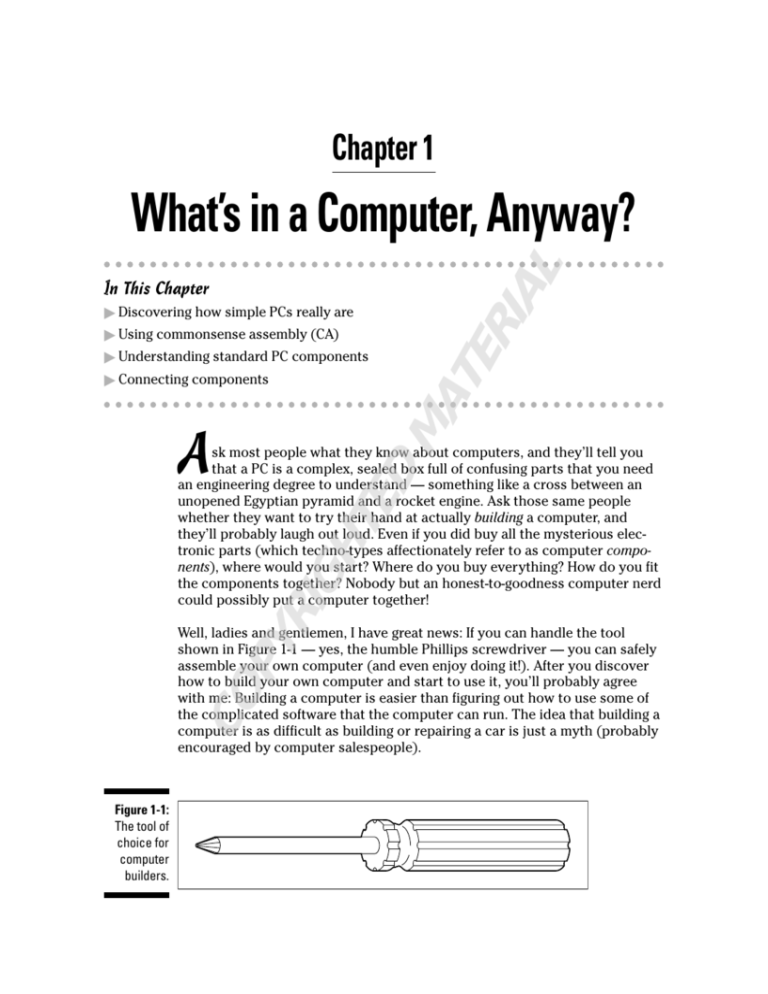
Chapter 1 AL What’s in a Computer, Anyway? In This Chapter RI Discovering how simple PCs really are Using commonsense assembly (CA) TE Understanding standard PC components MA Connecting components A RI GH TE D sk most people what they know about computers, and they’ll tell you that a PC is a complex, sealed box full of confusing parts that you need an engineering degree to understand — something like a cross between an unopened Egyptian pyramid and a rocket engine. Ask those same people whether they want to try their hand at actually building a computer, and they’ll probably laugh out loud. Even if you did buy all the mysterious electronic parts (which techno-types affectionately refer to as computer components), where would you start? Where do you buy everything? How do you fit the components together? Nobody but an honest-to-goodness computer nerd could possibly put a computer together! CO PY Well, ladies and gentlemen, I have great news: If you can handle the tool shown in Figure 1-1 — yes, the humble Phillips screwdriver — you can safely assemble your own computer (and even enjoy doing it!). After you discover how to build your own computer and start to use it, you’ll probably agree with me: Building a computer is easier than figuring out how to use some of the complicated software that the computer can run. The idea that building a computer is as difficult as building or repairing a car is just a myth (probably encouraged by computer salespeople). Figure 1-1: The tool of choice for computer builders. 10 Part I: Can I Really Do This? In this chapter, I introduce you to the standard electronics and peripherals that you can use to build your computer, and then I show you how they fit together. (And after you’ve successfully built your first computer, drop me an e-mail at mark@mlcbooks.com, and I can congratulate you personally!) Anyone Can Assemble a PC You might have heard a horror story or two about someone who tried to upgrade a PC and ended up being sucked through a black hole into another dimension. When you announce to the world that you’re going to build your own computer, you’re likely to face a number of common myths: “Why, you have to be practically psychic about how machinery works to stick your hands inside a computer!” Wrong. In fact, you don’t have to know how any of the components work, so you don’t have to be an expert in laser optics, magnetism, or electronic theory. You just need to connect the parts together correctly and attach them to the motherboard and computer case. “You can’t build a computer on a card table, you know. You’re going to need an airstrip, a complete toolkit, and a warehouse full of parts.” Nope. You can not only assemble a computer on your dining room table but also do so with no special tools. Find your favorite screwdriver, and you’re a lean, mean, computer-assembling machine. “It’s going to take you years to put together a computer. Heck, by the time you’re finished, your computer will already be out of date.” Depends on how long it takes. No, no — just kidding! This myth is definitely false. If you have all your components ready to go, assembling a PC is a first-time project that you can easily finish during a long weekend. “Something’s not going to work with something else. You’ll see.” Wrong again. (Geez, who are these people? They probably still think that airplanes will never get off the ground.) Today’s computer components are designed to work with each other. Regardless of what brand name you buy or how much you spend, if you buy a standard computer device, it should join in that big cooperative team effort that makes a working computer. What’s the secret to building a PC? Time for the first Mark’s Maxim for this book: There really isn’t a secret to building a PC. That’s why many people have started their own home businesses building custom computers in their spare time — and why thousands of my readers have built their own computers using this book. Building a computer is fun — that is, after you conquer your initial fear. Plus, you get a big ego boost after Chapter 1: What’s in a Computer, Anyway? people find out that you built your own computer. Suddenly, you’re a genuine PC guru to your family and friends, so be prepared to handle those technical support questions at your next party. Building a better mousetrap (or computer) Over the past few years, I’ve developed a simple rule for myself, which applies perfectly to building anything from a mousetrap to a computer. I call this rule CA — or, for those who can’t stand abbreviations, commonsense assembly. The idea is a simple one: You can prevent most mistakes while assembling a PC by using a little common sense. Keep the following CA rules in mind when handling and connecting computer components: Give yourself plenty of empty space and adequate lighting. If you’re building a computer on the dining table, make sure that your work area is covered with newspaper to avoid scratches. I also recommend keeping an adjustable desk lamp handy to shine light where you need it. Don’t start without all the necessary components. If you don’t have everything that you need to follow a project from beginning to end, don’t start yet (only to find you have to stop halfway through). It’s too easy to miss a step or forget something if you leave your computer’s bedside and come back the next day. Treat your components carefully. This commonsense rule doesn’t mean that you need to wear gloves when handling cables or that you need to refrigerate your adapter cards. Just don’t drop a part on the floor or toss it to a friend. Keep components in their antistatic packaging until you’re ready to install them. Follow the Three Absolutes of Component Care and Feeding. 1. Never bend a circuit board or an adapter card. 2. Always make sure the cables that connect your parts aren’t pinched. 3. Never try to make something fit. Take the component out, check the instructions again, and try it a different way if possible. Installing adapter cards on your motherboard can sometimes take a little longer or require a little more force than plugging a game cartridge into a video game. But determining whether a card is aligned correctly with the slot is usually easy because the slot is keyed to the shape of the corresponding card. 11 12 Part I: Can I Really Do This? Read any documentation that comes with each computer component. Although I provide step-by-step assembly instructions throughout this book, one of your components might require special switch settings or some other unique treatment. Keep all your parts manuals together for easy reference. After your computer is running, you can refer to your manuals quickly if you need to change any settings. In the future, if you want to sell the old device and upgrade, it’s considered good manners to provide the original manual with the component. (Complete with manual makes a better impression on eBay.) Save your boxes and receipts. Although it’s rare, you might find yourself stuck with a brand-new defective item, and you’ll need the original packaging to return it. Use bowls to hold small parts. Loose screws, jumpers, and wires have a habit of wandering off if left on their own. If you end up with extra screws or doodads after successfully assembling a PC, put these parts in a bowl and start your own spare-parts warehouse. Trust me: They’ll come in handy in the future. If you’re a true techno-nerd, get thee hence to a hardware store and buy one of those wall racks with all the little compartments — they’re perfect for organizing everything from screws to wires and jumpers. Keep a magnetic screwdriver handy. It never fails. Sooner or later, you end up dropping a screw inside your computer case. If no loose components are in the case, feel free to pick up the case, turn it upside down, and let gravity do its thing. However, if you’ve installed a component that’s not screwed down yet, I recommend using a magnetic screwdriver for picking up wayward screws. Check all connections after you install a component. I can’t explain this phenomenon (other than to invoke Murphy’s Law), but you’ll often connect a new component firmly only to discover later that you somehow disconnected some other connector accidentally. Never forget the common foe: static electricity. I’ll show you how you can easily ground yourself before you touch any circuitry or adapter cards — grounding sounds painful, but it’s not! Unless you ground yourself, you run the risk of damaging a component from the static electricity that might be lurking on your body. Leave the computer cover off during assembly. There’s no reason to replace the case’s cover immediately after installing a part — what if you connected a cable upside down? Instead, test your newly installed device first, if possible. As long as you don’t touch any of the circuit boards inside the case, you’ll be fine. By the way, nothing inside your machine will explode or spew nasty radiation, so you don’t have to step behind a lead screen when you fire it up. Simply make sure that you don’t touch any circuit boards inside while the machine is Chapter 1: What’s in a Computer, Anyway? running. Personally, I replace the case’s cover on a work-in-progress only at the end of the day (to fend off dust, felines, and small fingers). The primary, number-one, all-important, absolutely necessary, required rule Do not panic! There’s very little chance that you can destroy a component simply by connecting it the wrong way. Take your time while you build your computer and move at your own pace — you can avoid mistakes that way. Here’s an important Mark’s Maxim: Building a computer is not a contest, and there is no time limit. After you’ve gained experience and built a few machines, you can work on speed records; for now, just try to schedule as much uninterrupted time as possible. For example, I know several supertechs who can assemble a complete PC in a single hour. Of course, people often laugh at them at dinner parties — being a techno-nerd does have its dark side, I guess. The other primary, number-one, all-important, absolutely necessary, required rule Liquids are taboo! If you even so much as think of parking your soda or mineral water next to your computer (even just for a second), you might remind yourself of Chernobyl or Three Mile Island. If you spill beverages or other liquids on your computer components, that liquid will ruin everything that it touches — period. PCs Are Built with Standard Parts When the first personal computers appeared way back in the late 1970s, you had to be good with electronics — and a soldering iron — to build one. Everything was soldered by hand to circuit boards, and you even had to build the computer’s case yourself. A hacker (as applied to computers) was a person who “hacked together” a computer from bits and pieces of hardware. (Today, unfortunately, the word carries a darker connotation.) 13 14 Part I: Can I Really Do This? Computers have advanced a few light-years since then; now they’re more like appliances, in that one computer is put together pretty much like another. Ever since IBM introduced the IBM PC, computers have been built using standard components with the same connectors and dimensions, so you no longer need the experience of an electronics engineer to assemble one. And the parts are self-contained, so you don’t need to worry about soldering (or gears and springs, either). Everyone uses the same building blocks that fit together the same way. In fact, assembling standardized computer components is how popular mailorder and direct-sale computer manufacturers build their machines. Like you, they order standard computer components and peripherals and then follow a procedure (much like the ones that I describe in this book) to assemble the computer according to your specifications. The process that you follow to build your own computer is much like following a recipe. Like baking a cake, you add certain parts to your mixture in a certain order. Before you know it, you’re taking a big bite — or, in this case, using the Internet, writing the great American novel, or blasting your favorite aliens from the planet Quark. Understanding Your Computer’s Components Before you find out more about where to buy the parts that make up a computer (or, if you’re lucky, where to scavenge them), allow me to introduce you to each of the major components of your computer. I describe each component in general, although you can find out all the details about each computer part in other chapters of this book. By the way, scavenging parts is more wholesome than it sounds; I use the term to refer to components that you’ve removed from an older computer, used components that you’ve bought, or used parts that someone has given you. Check out Chapter 2 for some good tips and hints on where to scavenge computer components. The metal mansion Your computer’s case is its home, complete with a power supply, the various buttons and lights on the front, and the all-important fan that keeps the inside of your computer cool. Today’s high-power gaming machines have three or four fans, depending on how many devices inside are generating heat — heck, the fastest PCs that gamers build these days are liquid-cooled, just like your car! Chapter 1: What’s in a Computer, Anyway? You might notice several large, rectangular cutouts on the front of your case. Don’t worry — your computer case isn’t defective; it’s supposed to have them. These holes, called drive bays, enable you to add components, such as a tape backup drive or a DVD-ROM drive. An unused drive bay is usually covered by a plastic insert. Or the front of your case might have a door that swings open for access to the bays. You can get computer cases in various sizes. The size that you choose depends on how many toys (usually called peripherals) you want to add to your computer. See Chapter 3 for a more detailed discussion of your computer’s case. The big kahuna A number of different circuit boards are inside a computer, but only one is big enough, complicated enough, and important enough to be called your computer’s motherboard. Your computer motherboard holds The CPU chip: This acts as the brain of your PC. The RAM modules: These act as your computer’s memory while it’s turned on. All sorts of connectors: You connect lots of things to your motherboard, such as hard drives, a DVD drive, and power cables. In fact, the motherboard holds just about everything, as you can see in Figure 1-2. (PCI slots are covered in Chapter 4, and your motherboard’s BIOS makes an appearance in Chapters 3 and 7.) If you enjoy acronyms and abbreviations, you’ll be happy to know that CPU stands for central processing unit, and RAM stands for random access memory. Computer CPUs come in different speeds, measured in gigahertz (GHz), such as 3 GHz. Older processors used to be measured in megahertz (MHz), such as 350 MHz. Sometimes, the CPU speed is mentioned after the processor name, such as Pentium 4 3.06 GHz. In general, the faster the CPU speed, the faster your computer. The most popular brand of CPU these days is the Intel Pentium series, which includes the Pentium 4 and Pentium Extreme Edition, but you can also find processors from Advanced Micro Devices, which everyone calls AMD. AMD’s alternative CPUs are usually less expensive and often run faster and more efficiently than the Pentium 4. I discuss the most popular processors and their advantages later in Chapter 4. 15 16 Part I: Can I Really Do This? Built-in audio jacks PCI slots (white) CPU socket Figure 1-2: AGP slot Your (black) computer’s main circuit board, affectionately called the mother- Battery board. RAM slots IDE device connectors Motherboard power connector Your motherboard is probably one of the more expensive parts that you need to buy. If you can find a used motherboard in good shape with a Pentium 4 class CPU already installed, you should consider it if the price is right. What price is right? Motherboard prices fluctuate every month (usually downward), so check the price on a new motherboard that has a similar Pentium-series chip to determine whether you’re getting a good deal on the used board. I find Newegg (www.newegg.com), eBay (www.ebay.com), and PriceWatch (www.pricewatch.com) to be the best resources for checking prices. For all the details on your motherboard, see Chapter 3. I discuss CPU chips and RAM modules in Chapter 4. The eye candy Next on your list are the video card and monitor. Together, these two parts display everything from your e-mail to your latest financial figures to all those killer Web pages (and don’t forget those flashy enemy Quarkians you need to disintegrate). Chapter 1: What’s in a Computer, Anyway? All video cards have their own special, onboard RAM modules; the more RAM, the more colors and detail the card can display. Today’s state-of-the-art video cards also help speed up your computer while it displays 3-D graphics or digital video. The video card performs most of the display work itself, giving your CPU a well-deserved rest. (Note that many of today’s motherboards have a built-in video card, so you may not need a separate card if you’re not interested in playing the latest games.) Monitors have screen areas that typically range from 15 inches to 21 inches (measured diagonally across the case). You can go even larger if you crave that much space, or you can put two monitors side-by-side for a larger virtual desktop. Naturally, the larger the monitor, the more expensive it is. The latest liquid crystal display (LCD) monitors, which use less electricity and emit very little radiation, are more expensive than CRT (or tube) monitors of the same size. Chapter 6 contains just about everything that you ever (or never) wanted to know about video cards and PC monitors. The places for plugs Your power cord isn’t the only connection that you need on the outside of your computer. For example, you also need to attach a mouse and a keyboard (unless you’ve gone wireless), and you might also want to add a portable MP3 player, a gamepad, a digital camera, and a printer. These days, virtually all the ports (the connectors so proudly displayed on the back of your PC) are built into the motherboard, but you can install new ports for external devices separately. You can point and click with things other than a mouse, such as a trackball, a touchpad, or a drawing tablet. A mouse is practically a requirement for Windows (although you can still navigate strictly from the keyboard if necessary). Even the traditional keyboard has changed. Ergonomically shaped keyboards are designed to make typing easier on your hands, wrists, and forearms. And Windows XP recognizes two or three new keys to activate the Start button and display menus in an application. (Thank goodness Bill Gates can’t add new letters to the alphabet.) However, if you can scavenge a standard PC keyboard, it should still work just fine. Your computer also needs at least one universal serial bus (USB) and one parallel port to use many external devices. For example, most digital cameras are connected with USB ports, and your printer can use either a parallel port or a USB port. Other proprietary, specialized ports (such as a FireWire port for digital video) might end up sticking out the back of your new computer, 17 18 Part I: Can I Really Do This? depending on what components you add. (Need the complete rundown on ports? Jump to Chapter 5.) Oh, and don’t forget your Ethernet network port. Many motherboards now have built-in Ethernet cards, or you can add an Ethernet network adapter card separately. For all the details on building your own network (or connecting your new PC to an existing network), swing by Chapter 12. The data warehouse Earlier in this chapter, I mention that your RAM modules act as your computer’s memory while the computer is running. However, when you switch off your computer, it forgets the data in RAM, so you need a permanent place to store Uncle Milton’s Web page address or your latest stock report. This permanent storage comes in three forms: hard drive, removable storage drive (for example, a CD/DVD recorder or a Zip drive), and floppy disk drive (with its accompanying floppy disk). Your computer includes at least one hard drive and one floppy drive; the standard PC floppy drive still uses a 31⁄2-inch disk that holds 1.44MB. Hard drives, on the other hand, have much greater storage capacities. Older drives can store hundreds of megabytes (MB), but newer hard drives hold gigabytes (GB) of data (that’s 1000 megabytes). At the time of this writing, typical hard drives range in capacity from 40GB to more than 300 or 400GB — and those figures are constantly rising, while costs are constantly dropping. (You’ve gotta love that free-market competitive model!) Newer hard drives are typically faster than old drives, too. The new ones can deliver more data to your computer in less time than drives made as little as two or three years ago. If you’re buying a new hard drive, buy as much data territory as possible. Chapter 7 is your guide to both hard drives and floppy drives. The bells and whistles Today’s multimedia PCs have almost more extras, add-ons, and fun doodads than any mere mortal can afford — well, except for Bill Gates, that is. If you want to be able to install and run today’s software, though, you need at least a CD-ROM drive. Multimedia applications and games also need a sound card (or built-in audio hardware on your motherboard), along with a set of speakers. In Chapter 8, I tell you more about CD-ROM and DVD drives, and Chapter 9 has the skinny on PC sound cards. Another common addition to a PC is a printer. If you need the lowdown on today’s printer technology, jump to Chapter 14. And don’t forget a dial-up Chapter 1: What’s in a Computer, Anyway? modem for connecting your computer to other computers across telephone lines, especially if you’re an Internet junkie. (I cover modems in Chapter 10.) If a high-speed cable or DSL Internet connection is available in your area and you can afford it, you can jump on the Internet broadbandwagon. (That’s so bad it doesn’t even qualify as a pun.) In later chapters, I also discuss advanced stuff for power users, such as network hardware and scanners. You don’t have to read those chapters, and you won’t be tested on them. But they’re there in case you feel adventurous (or you really need them). Connecting Your Computer Components You might be wondering how to connect all the various components that make up a computer. “What happens if I connect something wrong? Am I going to light up like a Christmas tree? Will I burn up an expensive part?” I admit that when I built my first computer in the early 90s, I had these same concerns. To reassure you, consider these facts: Most connectors for computer components are marked to help you plug them in correctly. In fact, some connectors are designed so that you can install them in only one direction. Ruining a computer component simply by plugging it in the wrong way is almost impossible. At the worst, the device simply won’t work. Just connect the component properly, and it should work just fine. Although you connect your computer to a wall socket, unless you disassemble the power supply or monitor (which you are not going to do), you won’t be exposed to dangerous voltage. Of course, it pays to take basic precautions — such as unplugging your PC each time you add or remove a component. Most components within a computer are connected with cables. For example, Figures 1-3 and 1-4 show a floppy drive cable and a power cable, respectively. I give you instructions on how to make sure that you’re connecting cables properly. You’ll also be adding adapter cards. These circuit boards plug into your computer, much like how a game cartridge plugs into a video game. Adapter cards provide your computer with additional features — for example, you can add a sound card (see Chapter 9) and an internal modem (see Chapter 10) to provide better audio and a dial-up Internet connection, respectively. Adapter cards are arranged in rows at one end of a computer, as shown in Figure 1-5. 19 20 Part I: Can I Really Do This? Connector Figure 1-3: A typical floppy drive cable connector. Marked edge of ribbon cable indicates pin 1 Figure 1-4: A PC power cable — can you ever have too many? Cable from power supply Connector on a component Adapter cards Empty slot Figure 1-5: Adapter cards installed in a computer. Depending on the type of motherboard that you install, you’ll use PCI, PCIExpress, or AGP adapter cards. In Chapter 3, I explain how to select the right type of adapter card as well as what all those NASA-inspired abbreviations mean. Make sure that you get the right kind of adapter card because the wrong type of card won’t fit.



